RIP5 Interacts with REL1 and Negatively Regulates Drought Tolerance in Rice
Abstract
:1. Introduction
2. Materials and Methods
2.1. Obtainment of the Mutants
2.2. Plant Materials and Growth Conditions
2.3. Yeast Two-Hybrid Assays (Y2H) and BIMO-Lecular Fluorescence Complementation (BiFC)
2.4. Bioinformatics Analysis
2.5. Subcellular Localization of RIP5
2.6. Total RNA Isolation and Quantitative Real-Time PCR
2.7. Expression Profile Analysis of RIP5 and AAO families
2.8. Drought-Stress Treatment
2.9. Ascorbate Oxidase (AAO) Activity Assay and Ascorbic Acid (AsA) Measurement
2.10. RNA-Sequencing and Data Analysis
2.11. Data Analysis
3. Results
3.1. REL1 Physically Interacts with RIP5
3.2. Phylogenetic Analysis of RIP5 and Expression Patterns of OsAAOs Family to Drought Stress
3.3. The Expression Characteristics Analysis and Subcellular Localization of RIP5
3.4. RIP5 Negatively Regulates Drought-Stress Tolerance in Rice
3.5. RIP5 Negatively Regulates Drought Response by Affecting the Content of AsA
3.6. REL1 Is Involved in Regulating Drought Tolerance by Inhibiting RIP5
3.7. Analysis of Transcriptome Assay between rip5-ko and ZH11 under PEG Stress
4. Discussion
Supplementary Materials
Author Contributions
Funding
Data Availability Statement
Conflicts of Interest
References
- Rezvi, H.U.A.; Tahjib-Ul-Arif, M.; Azim, M.A.; Tumpa, T.A.; Tipu, M.M.H.; Najnine, F.; Dawood, M.F.A.; Skalicky, M.; Brestic, M. Rice and food security: Climate change implications and the future prospects for nutritional security. Food Energy Secur. 2022, 12, e430. [Google Scholar] [CrossRef]
- Xie, J.; Hu, B.; Wan, Y.; Zhang, T.; Li, X.; Liu, R.; Huang, Y.; Dao, L.; Luo, X. Comparison of the drought resistance characters at Seedling Stage between Dongxiang Common Wild rice (Oryza rufipogon Griff.) and cultivars (Oryza sativa L.). Agric. Food Sci. 2010, 30, 1665–1674. [Google Scholar]
- Wang, Y.; Wang, J.; Sarwar, R.; Zhang, W.; Geng, R.; Zhu, K.M.; Tan, X.L. Research progress on physiological response and molecular mechanism of cold response in plants. Front. Plant Sci. 2024, 15, 1334913. [Google Scholar] [CrossRef]
- Cao, M.J.; Zhang, Y.L.; Liu, X.; Huang, H.; Zhou, X.E.; Wang, W.L.; Zeng, A.; Zhao, C.Z.; Si, T.; Du, J.M.; et al. Combining chemical and genetic approaches to increase drought resistance in plants. Nat. Commun. 2017, 8, 1183. [Google Scholar] [CrossRef]
- Rudenko, N.N.; Vetoshkina, D.V.; Marenkova, T.V.; Borisova-Mubarakshina, M.M. Antioxidants of non-enzymatic nature: Their function in higher plant cells and the ways of boosting their biosynthesis. Antioxidants 2023, 12, 2014. [Google Scholar] [CrossRef]
- Li, H.Y.; Wang, Y.C.; Xia, F.S.; Li, Y.L.; Wang, C.C.; Wang, B.; Dong, K.H. Influence of exogenous H2O2 priming on AsA-GSH cycle in the oat embryonic mitochondria. Caodi Xuebao Acta Agrestia Sin. 2022, 30, 2298–2305. [Google Scholar]
- Yang, X.; Wang, J.Y.; Mao, X.G.; Li, C.N.; Li, L.; Xue, Y.H.; He, L.H.; Jing, R.L. A Locus Controlling Leaf Rolling Degree in Wheat under Drought Stress Identified by Bulked Segregant Analysis. Plants 2022, 11, 2076. [Google Scholar] [CrossRef] [PubMed]
- Kato, N.; Esaka, M. cDNA cloning and gene expression of ascorbate oxidase in tobacco. Plant Mol. Biol. 1996, 30, 833–837. [Google Scholar] [CrossRef] [PubMed]
- Hossain, M.A.; Munné-Bosch, S.; Burritt, D.J.; Diaz-Vivancos, P.; Fujita, M.; Lorence, A. (Eds.) Ascorbic Acid in Plant Growth, Development and Stress Tolerance; Springer International Publishing: Basel, Switzerland, 2017; p. 514. [Google Scholar]
- Batth, R.; Singh, K.; Kumari, S.; Mustafiz, A. Transcript profiling reveals the presence of abiotic stress and developmental stage specific ascorbate oxidase genes in plants. Front. Plant Sci. 2017, 8, 198. [Google Scholar] [CrossRef] [PubMed]
- Sanmartin, M.; Drogoudi, P.A.M.D.; Lyons, T.; Pateraki, I.; Barnes, J.; Kanellis, A.K. Over-expression of ascorbate oxidase in the apoplast of transgenic tobacco results in altered ascorbate and glutathione redox states and increased sensitivity to ozone. Planta 2003, 216, 918–928. [Google Scholar] [CrossRef] [PubMed]
- Yamamoto, A.; Bhuiyan, M.N.H.; Waditee, R.; Tanaka, Y.; Esaka, M.; Oba, K.; Jagendorf, A.T.; Takabe, T. Suppressed expression of the apoplastic ascorbate oxidase gene increases salt tolerance in tobacco and Arabidopsis plants. J. Exp. Bot. 2005, 56, 1785–1796. [Google Scholar] [CrossRef] [PubMed]
- Singh, R.R.; Verstraeten, B.; Siddique, S.; Tegene, A.M.; Tenhaken, R.; Frei, M.; Haeck, A.; Demeestere, K.; Pokhare, S.; Gheysen, G.; et al. Ascorbate oxidation activates systemic defence against root-knot nematode Meloidogyne graminicola in rice. J. Exp. Bot. 2020, 71, 4271–4284. [Google Scholar] [CrossRef] [PubMed]
- Wu, J.G.; Yang, R.X.; Yang, Z.R.; Yao, S.Z.; Zhao, S.S.; Wang, Y.; Li, P.C.; Song, X.W.; Jin, L.; Lan, Y.; et al. ROS accumulation and antiviral defence control by microRNA528 in rice. Nat. Plants 2017, 3, 16203. [Google Scholar] [CrossRef]
- Chen, Q.L.; Xie, Q.J.; Gao, J.; Wang, W.Y.; Sun, B.; Liu, B.H.; Zhu, H.T.; Peng, H.F.; Zhao, H.B.; Liu, C.H.; et al. Characterization of Rolled and Erect Leaf 1 in regulating leave morphology in rice. J. Exp. Bot. 2015, 66, 6047–6058. [Google Scholar] [CrossRef] [PubMed]
- Liang, J.; Guo, S.; Sun, B.; Liu, Q.; Chen, X.; Peng, H.; Zhang, Z.; Xie, Q. Constitutive expression of REL1 confers the rice response to drought stress and abscisic acid. Rice 2018, 11, 59. [Google Scholar] [CrossRef] [PubMed]
- Zhang, Q.X.; Liu, G.M.; Jin, J.; Liang, J.Y.; Zhang, J.J.; Peng, H.F.; Wang, W.Y.; Zhang, Z.M. RIP2 interacts with REL1 to control leaf architecture by modulating brassinosteroid signaling in rice. Theor. Appl. Genet. 2022, 135, 979–991. [Google Scholar] [CrossRef]
- Wang, M.M.; Zhu, X.P.; Huang, Z.; Chen, M.H.; Xu, P.; Liao, S.T.; Zhao, Y.Z.; Gao, Y.N.; He, J.H.; Luo, Y.T.; et al. Controlling diurnal flower-opening time by manipulating the jasmonate pathway accelerates development of indica-japonica hybrid rice breeding. Plant Biotechnol. J. 2024; ahead of print. [Google Scholar] [CrossRef] [PubMed]
- Peng, G.Q.; Liu, M.L.; Zhu, L.Y.; Luo, W.L.; Wang, Q.H.; Wang, M.M.; Chen, H.Q.; Luo, Z.L.; Xiao, Y.P.; Zhang, Y.J.; et al. The E3 ubiquitin ligase CSIT1 regulates critical sterility-inducing temperature by ribosome-associated quality control to safeguard two-line hybrid breeding in rice. Mol. Plant 2023, 16, 1695–1709. [Google Scholar] [CrossRef]
- Chen, H.Q.; Zhang, S.Q.; Li, R.Q.; Peng, G.Q.; Chen, W.P.; Rautengarten, C.; Liu, M.L.; Zhu, L.Y.; Xiao, Y.P.; Song, F.S.; et al. BOTRYOID POLLEN 1 regulates ROS-triggered PCD and pollen wall development by controlling UDP-sugar homeostasis in rice. Plant Cell 2023, 35, 3522–3543. [Google Scholar] [CrossRef]
- Yamaguchi-Shinozaki, K.; Shinozaki, K. Transcriptional regulatory networks in cellular responses and tolerance to dehydration and cold stresses. Annu. Rev. Plant Biol. 2006, 57, 781–803. [Google Scholar] [CrossRef]
- Hu, H.; Xiong, L. Genetic engineering and breeding of drought-resistant crops. Annu. Rev. Plant Biol. 2014, 65, 715–741. [Google Scholar] [CrossRef] [PubMed]
- Fang, Y.; Xiong, L. General mechanisms of drought response and their application in drought resistance improvement in plants. Cell. Mol. Life Sci. 2015, 72, 673–689. [Google Scholar] [CrossRef] [PubMed]
- Geng, A.J.; Lian, W.L.; Wang, Y.H.; Zhang, Y.; Wang, X.; Chen, G. Molecular Mechanisms and Regulatory Pathways Underlying Drought Stress Response in Rice. Int. J. Mol. Sci. 2024, 25, 1185. [Google Scholar] [CrossRef] [PubMed]
- Chen, G.; Lian, W.; Geng, A.; Wang, Y.; Liu, M.; Zhang, Y.; Wang, X. pOsHAK1:OsSUT1 promotes sugar transport and enhances drought tolerance in rice. Int. J. Mol. Sci. 2024, 25, 2158. [Google Scholar] [CrossRef] [PubMed]
- Zhang, M.X.; Zhao, R.R.; Huang, K.; Wei, Z.Q.; Guo, B.Y.; Huang, S.Z.; Li, Z.; Jiang, W.Z.; Wu, T.; Du, X.L. OsWRKY76 positively regulates drought stress via OsbHLH148-mediated jasmonate signaling in rice. Front. Plant Sci. 2023, 14, 1168723. [Google Scholar] [CrossRef] [PubMed]
- Seo, J.S.; Joo, J.; Kim, M.J.; Kim, Y.K.; Nahm, B.H.; Song, S.I.; Cheong, J.J.; Lee, J.S.; Kim, J.K.; Choi, Y.D. OsbHLH148, a basic helix-loop-helix protein, interacts with OsJAZ proteins in a jasmonate signaling pathway leading to drought tolerance in rice. Plant J. 2011, 65, 907–921. [Google Scholar] [CrossRef] [PubMed]
- Ning, J.; Li, X.H.; Hicks, L.M.; Xiong, L.Z. A raf-Like MAPKKK gene DSM1 mediates drought resistance through reactive oxygen species scavenging in rice. Plant Physiol. 2009, 152, 876–890. [Google Scholar] [CrossRef]
- Yang, A.; Dai, X.; Zhang, W. A R2R3-type MYB gene, OsMYB2, is involved in salt, cold, and dehydration tolerance in rice. J. Exp. Bot. 2012, 63, 2541–2556. [Google Scholar] [CrossRef]
- Pignocchi, C.; Fletcher, J.M.; Wilkinson, J.E.; Barnes, J.D.; Foyer, C.H. The function of ascorbate oxidase in tobacco. Plant Physiol. 2003, 132, 1631–1641. [Google Scholar] [CrossRef]
- Akram, N.A.; Shafiq, F.; Ashraf, M. Ascorbic acid-a potential oxidant scavenger and its role in plant development and abiotic stress tolerance. Front. Plant Sci. 2017, 8, 613. [Google Scholar] [CrossRef]
- Saed-Moucheshi, A.; Shekoofa, A.; Pessarakli, M. Reactive oxygen species (ROS) generation and detoxifying in plants. J. Plant Nutr. 2014, 37, 1573–1585. [Google Scholar] [CrossRef]
- Wang, Y.Y.; Zhao, H.; Qin, H.; Li, Z.X.; Liu, H.; Wang, J.; Zhang, H.W.; Quan, R.D.; Huang, R.F.; Zhang, Z.J. The synthesis of ascorbic acid in rice roots plays an important role in the salt tolerance of rice by scavenging ROS. Int. J. Mol. Sci. 2018, 19, 3347. [Google Scholar] [CrossRef] [PubMed]
- Wang, J.; Huang, R.F. Modulation of ethylene and ascorbic acid on reactive oxygen species scavenging in plant salt response. Front. Plant Sci. 2019, 10, 319. [Google Scholar] [CrossRef] [PubMed]
- Ameer, K.; Iram, I.; Amin, S.; Humera, N.; Farooq, A.; Ibrahim, M. Alleviation of adverse effects of salt stress in brassica (Brassica campestris) by pre-sowing seed treatment with ascorbic acid. Am. Eurasian J. Agric. Environ. Sci. 2010, 7, 557–560. [Google Scholar]
- Cruz de Carvalho, M.H. Drought stress and reactive oxygen species: Production, scavenging and signaling. Plant Signal. Behav. 2008, 3, 156–165. [Google Scholar] [CrossRef]
- Zhang, J.H.; Jia, W.S.; Yang, J.C.; Ismail, A.M. Role of ABA in integrating plant responses to drought and salt stresses. Field Crops Res. 2006, 97, 111–119. [Google Scholar] [CrossRef]
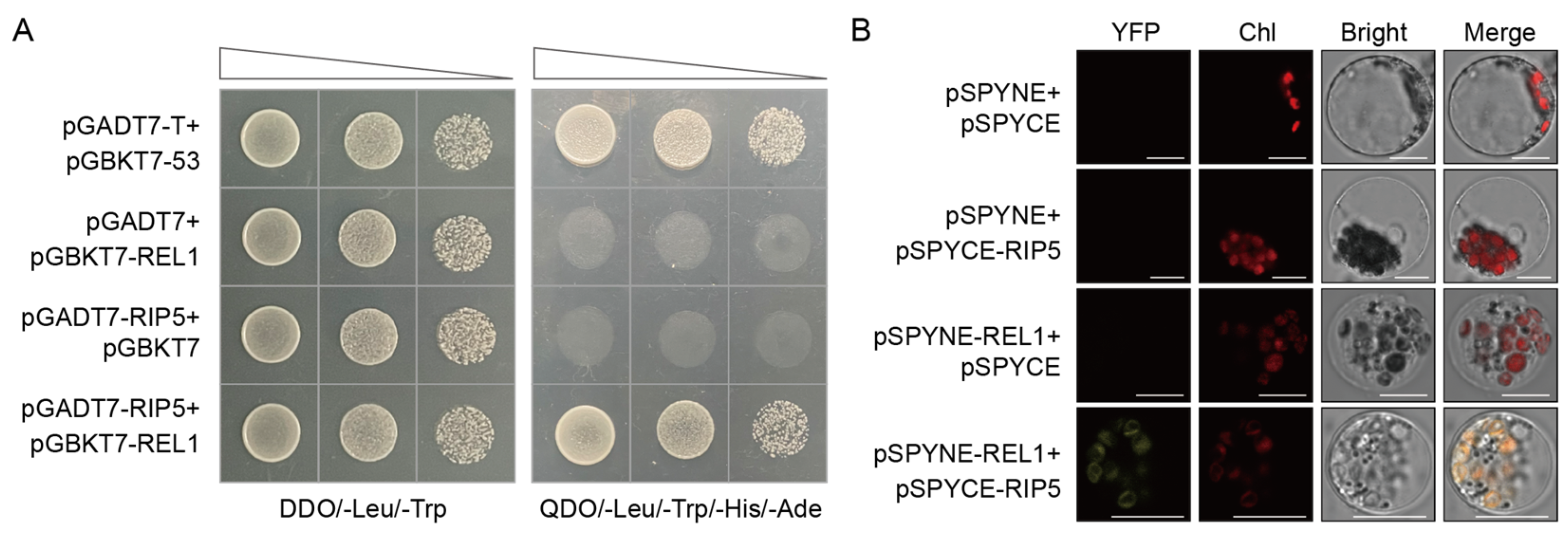
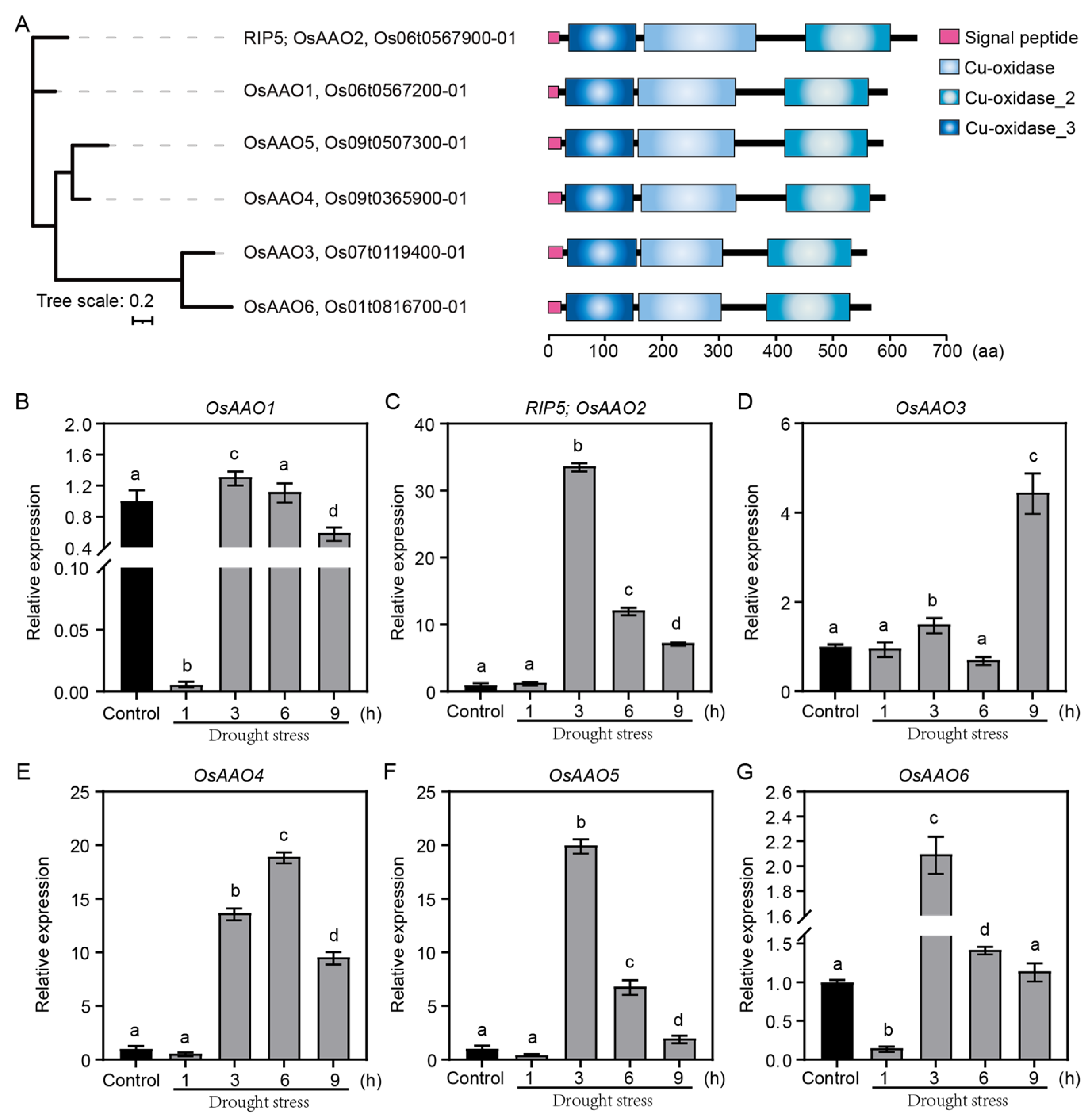


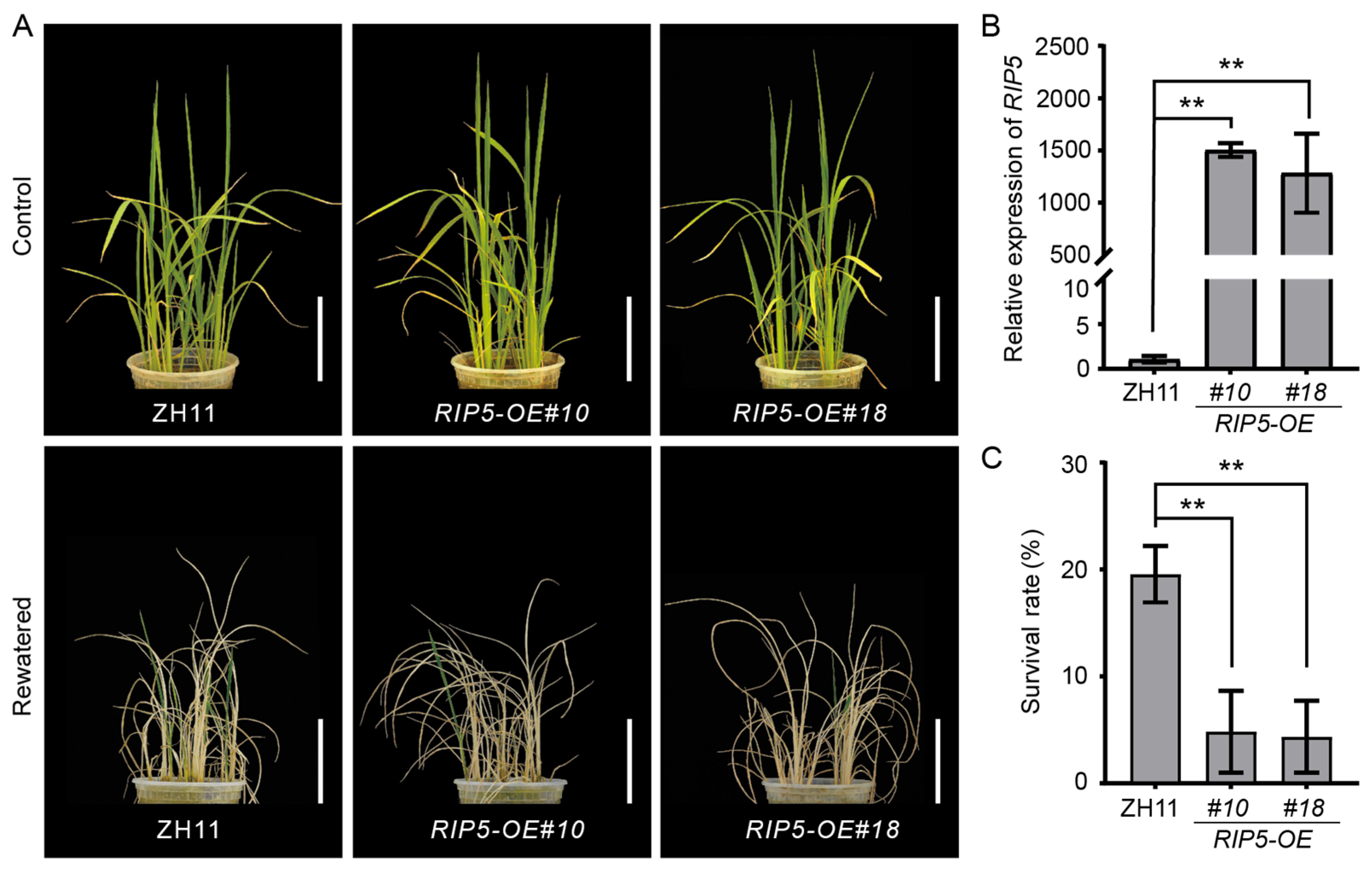

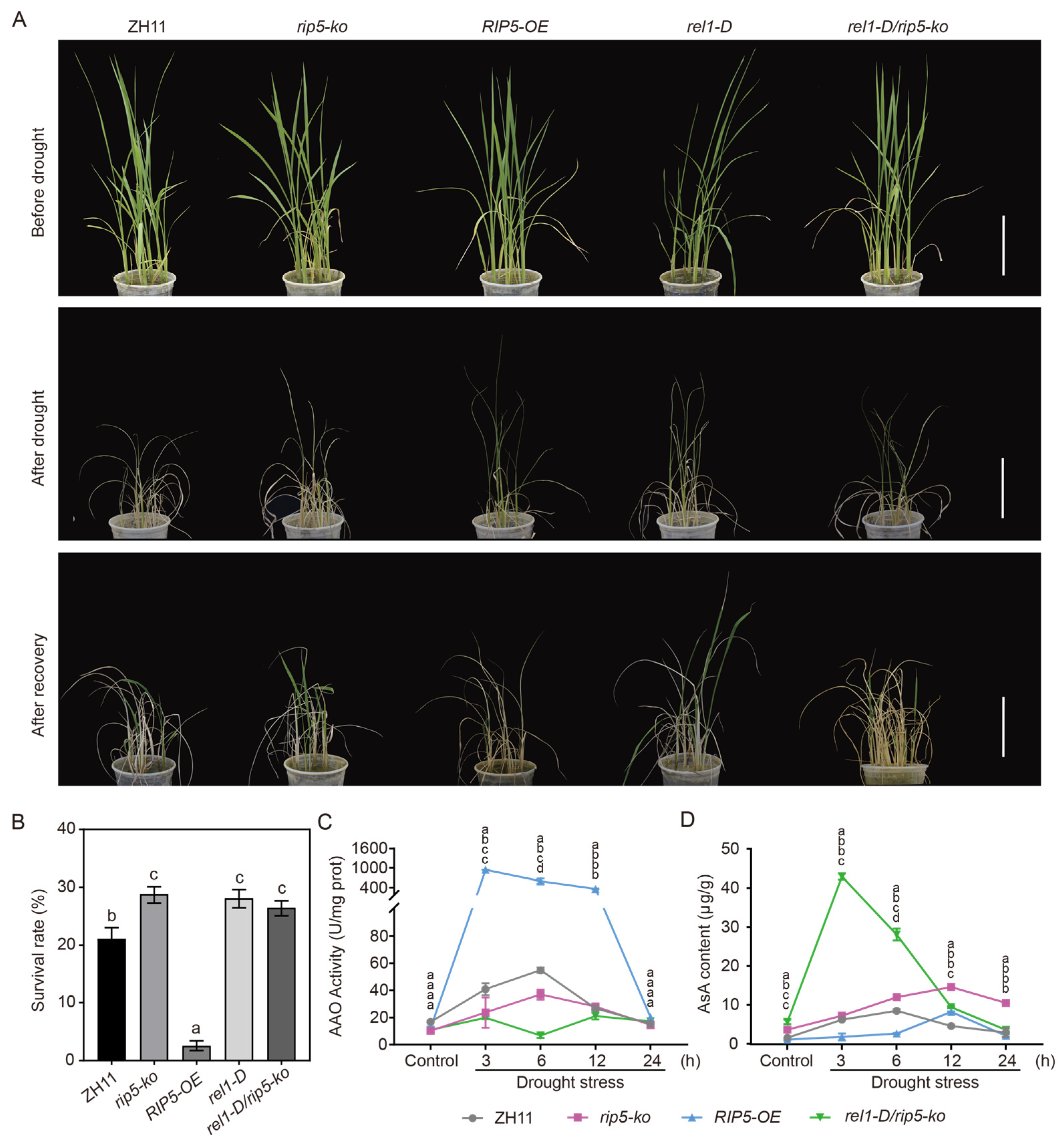


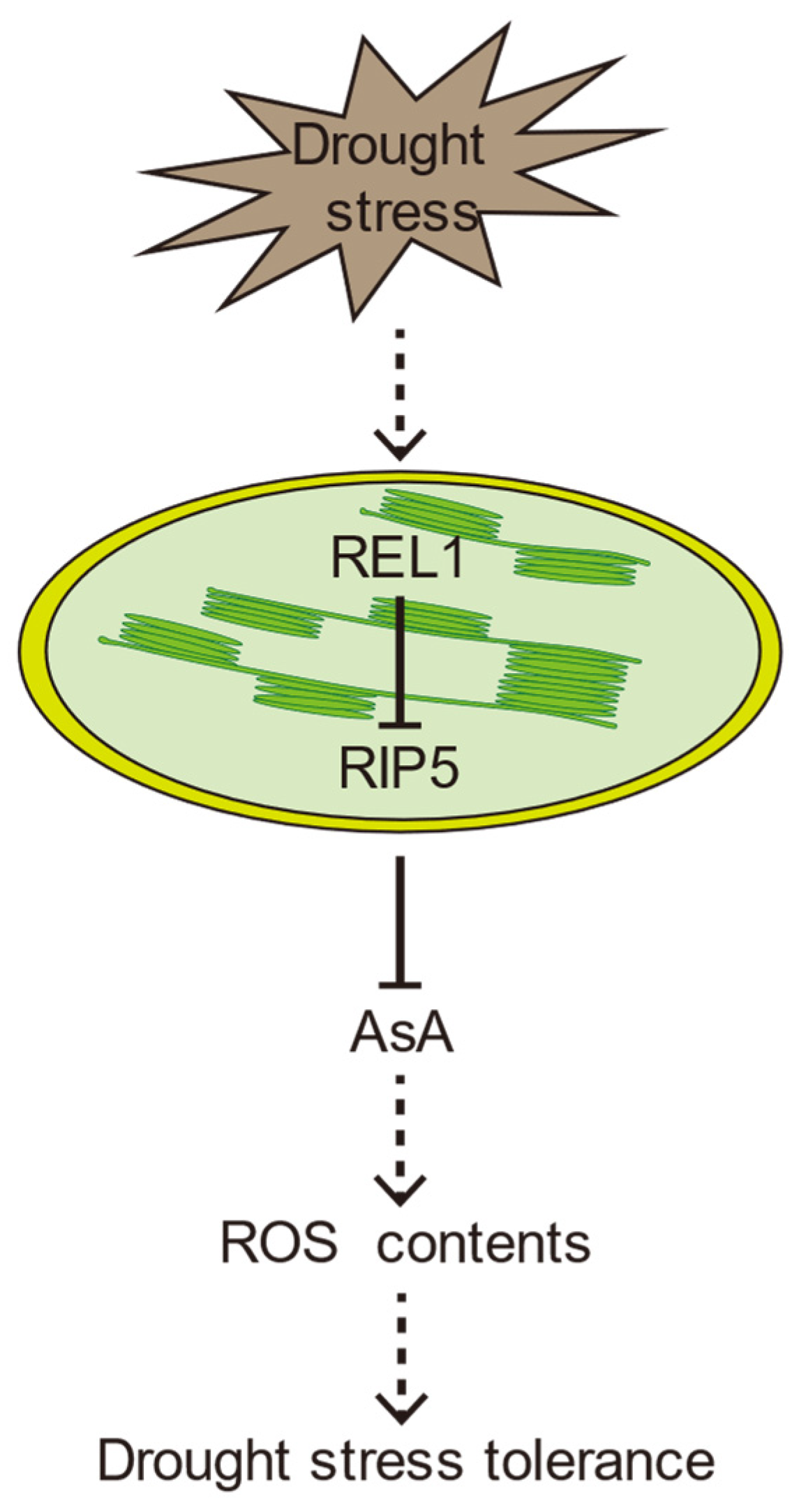
Disclaimer/Publisher’s Note: The statements, opinions and data contained in all publications are solely those of the individual author(s) and contributor(s) and not of MDPI and/or the editor(s). MDPI and/or the editor(s) disclaim responsibility for any injury to people or property resulting from any ideas, methods, instructions or products referred to in the content. |
© 2024 by the authors. Licensee MDPI, Basel, Switzerland. This article is an open access article distributed under the terms and conditions of the Creative Commons Attribution (CC BY) license (https://creativecommons.org/licenses/by/4.0/).
Share and Cite
Zhang, Q.; He, D.; Zhang, J.; He, H.; Guan, G.; Xu, T.; Li, W.; He, Y.; Zhang, Z. RIP5 Interacts with REL1 and Negatively Regulates Drought Tolerance in Rice. Cells 2024, 13, 887. https://doi.org/10.3390/cells13110887
Zhang Q, He D, Zhang J, He H, Guan G, Xu T, Li W, He Y, Zhang Z. RIP5 Interacts with REL1 and Negatively Regulates Drought Tolerance in Rice. Cells. 2024; 13(11):887. https://doi.org/10.3390/cells13110887
Chicago/Turabian StyleZhang, Qiuxin, Dan He, Jingjing Zhang, Hui He, Guohua Guan, Tingting Xu, Weiyan Li, Yan He, and Zemin Zhang. 2024. "RIP5 Interacts with REL1 and Negatively Regulates Drought Tolerance in Rice" Cells 13, no. 11: 887. https://doi.org/10.3390/cells13110887




